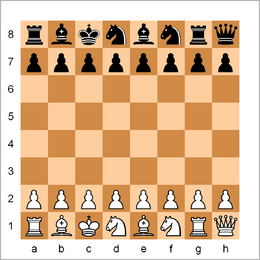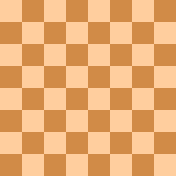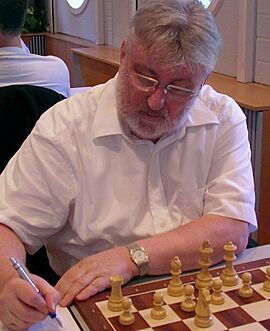Chess960 facts for kids

One of 960 possible starting setups. Black's setup always mirrors White's.
|
|
| Years active | Since June 19, 1996 |
|---|---|
| Genre(s) |
|
| Players | 2 |
| Setup time | ≈1 min + 1 min to determine starting position |
| Playing time | Casual games: 10–60 min Tournament games: from 10 min (fast chess) to 6 hours |
| Random chance | Pieces are randomized |
| Skill(s) required | Strategy, tactics |
| Synonym(s) | Fischer Random Chess |
| This article uses algebraic notation to describe chess moves. |
Chess960, also known as Fischer Random Chess, is a fun and exciting chess variant. It was created by former world chess champion Bobby Fischer in 1996. The main idea behind Chess960 is to make the game more about skill and creativity, and less about memorizing opening moves.
In regular chess, the pieces always start in the same spot. This means players can spend a lot of time studying and remembering the best first moves. But in Chess960, the starting positions of the pieces (not the pawns!) are mixed up. This makes every game feel new and different right from the start.
Chess960 uses the same board and pieces as classical chess. However, the way the pieces are placed on the first and last rows is random. There are 960 different ways the pieces can be set up. This randomness means you can't just memorize openings. Instead, you have to think on your feet and use your own chess skills!
In 2008, FIDE, the world chess organization, officially recognized Chess960. The first official world championship for this variant was held in 2019. It was won by Wesley So. In 2022, Hikaru Nakamura became the new champion.
Contents
Setting Up the Game
Before a Chess960 game begins, a special starting position is chosen randomly. This setup follows a few important rules:
- White's main pieces (like rooks, knights, bishops, queen, and king) are placed randomly on the first row.
- The two bishops must always be on squares of opposite colors (one on a light square, one on a dark square).
- The king must always be placed somewhere between the two rooks.
Black's pieces are then placed in the exact opposite spots to White's pieces. For example, if White's king is on f1, Black's king will be on f8. The pawns are placed on the second row, just like in regular chess.
Once the pieces are set up, the game is played exactly like classical chess. The only big difference is how castling works, because the king and rooks might start in different places.
How to Create Starting Positions
There are 960 possible starting positions in Chess960. Usually, a computer program or online game will pick a random position for you.
If you don't have a computer, you can use dice or cards to choose a random setup. One simple way uses a standard six-sided die:
- First, decide where the light-square bishop goes. Roll the die. If it's 1, 2, 3, or 4, pick one of the four light squares. If it's 5 or 6, roll again.
- Do the same for the dark-square bishop.
- Now, you have six empty squares left. Roll the die to place the queen and the two knights.
- Finally, there will be three empty squares left. The king and the two rooks go into these spots. The king must always be in the middle of the two rooks.
Naming the Game
This chess variant has had a few different names. Bobby Fischer first called it "Fischerandom" or "Fischerandom chess".
Later, a group led by Hans-Walter Schmitt wanted a new name. They wanted a name that:
- Didn't use anyone's name.
- Didn't sound negative (like "random" or "freestyle").
- Could be understood by everyone.
They chose "Chess960" (pronounced "Chess nine-sixty"). This name was picked because there are exactly 960 possible starting positions in the game.
Bobby Fischer himself later said he liked the name "Chess960" and sometimes used it. Other names have also popped up, like "Chess 9LX" and "Freestyle chess".
Castling Rules
In Chess960, you can still castle once per game, just like in regular chess. This is a special move where you move both your king and a rook at the same time. However, because the pieces start in different spots, the castling rules are a bit different.
The goal of castling in Chess960 is to get your king and rook to the same final positions as in classical chess:
|
||||||||||||||||||||||||||||||||||||||||||||||||||||||||||||||||||||||||||||||||||||||||||
- After castling towards the 'a' side (which is like queenside castling in regular chess), the king ends up on the 'c' column. The rook from the 'a' side ends up on the 'd' column. This move is written as 0-0-0.
- After castling towards the 'h' side (like kingside castling), the king ends up on the 'g' column. The rook from the 'h' side ends up on the 'f' column. This move is written as 0-0.
The rules for when you can castle are similar to regular chess:
- Neither the king nor the rook you want to castle with can have moved before.
- No squares the king moves through or lands on can be attacked by an enemy piece.
- All squares between the king and the castling rook must be empty.
Sometimes, in Chess960, the king or rook might already be on its final castling square. In that case, only the other piece moves. Also, it's possible for castling to be your very first move in the game!
Game Strategy
| a | b | c | d | e | f | g | h | ||
| 8 |

|
8 | |||||||
| 7 | 7 | ||||||||
| 6 | 6 | ||||||||
| 5 | 5 | ||||||||
| 4 | 4 | ||||||||
| 3 | 3 | ||||||||
| 2 | 2 | ||||||||
| 1 | 1 | ||||||||
| a | b | c | d | e | f | g | h | ||
Since every game starts differently, you can't rely on memorized openings. You have to think creatively from the very first move! But some basic chess ideas still apply:
- Keep your king safe.
- Control the center of the board.
- Develop your pieces quickly, starting with the less valuable ones.
In many starting positions, some pawns might not be protected. You'll need to deal with these quickly to avoid losing them. For example, in some Chess960 games, a pawn can be attacked on the very first move, which doesn't happen in regular chess.
White's Advantage
In regular chess, White usually has a small advantage because they move first. In Chess960, this advantage can change depending on the starting position. Some positions might give White a bigger advantage, while others are more balanced.
Studies have shown that, on average, Chess960 starting positions are actually more balanced than the standard starting position in classical chess. This means the game is often fairer for both players.
History of Random Chess
The idea of mixing up chess pieces isn't new. It was first suggested a long time ago by a Dutch chess fan named Philip Julius van Zuylen van Nijevelt in 1792. He didn't like how repetitive chess openings could be. He wanted to make the game more unpredictable.
His book, La Supériorité aux Échecs, became very popular and was translated into many languages. He believed that randomizing the pieces would create so many different situations that "no one can study them beforehand." This early idea helped set the stage for Chess960.
Bobby Fischer's Influence
Bobby Fischer, a famous world chess champion, took this idea and made it better. He started working on his new version of chess in the early 1990s. He officially introduced his rules for "Fischer Random Chess" in 1996.
Fischer wanted to remove the need for players to memorize long sequences of opening moves. He believed that this memorization was making classical chess less creative and more about who had studied the most. By randomizing the start, players would have to use their own talent and come up with new strategies from the very beginning.
Fischer's rules added important conditions, like the bishops being on opposite colors and the king being between the rooks. These rules made sure the game still felt like chess and kept it exciting. He said, "I invented Fischerandom chess to keep chess going. Because I consider the old chess is dying, it really is dead."
Tournaments and Championships
Chess960 has grown in popularity, and many tournaments are now held around the world.
Early Tournaments
- The very first Fischer Random Chess tournament happened in Yugoslavia in 1996.
- The Netherlands has held its own Fischer Random Championships every year since 2006.
- In 2010, the US Chess Federation held its first Chess960 tournament.
- The British Chess960 Championship started in 2012.
Mainz Championships
For many years, the city of Mainz in Germany hosted big Chess960 tournaments. These events helped make the game more famous, even though FIDE didn't officially recognize them at first.
- In 2001, Peter Leko won an important match against Michael Adams.
- In 2003, Peter Svidler became the first "World New Chess Association" champion in Mainz.
- Many top players like Levon Aronian and Hikaru Nakamura have won titles at Mainz.
- In 2006, Alexandra Kosteniuk became the first Chess960 Women's World Champion.
Computers Playing Chess960
Chess programs also play Chess960! In 2005, the first Chess960 computer world championship was held. Programs like Shredder and Rybka have won these titles.
Since 2019, the Top Chess Engine Championship (TCEC) has held Chess960 tournaments for computers. Stockfish has won most of these events. There's even a "Double Fischer Random Chess" where both White's and Black's starting positions are random and not mirrored, leading to over 900,000 possible setups!
Big Matches and Championships
- In 2018, a special match was held between Magnus Carlsen, a former world champion, and Hikaru Nakamura. Carlsen won the match.
- The Saint Louis Chess Club in the USA hosts a popular Chess960 event called "Chess 9LX" every year. Many famous grandmasters play in it.
- In 2019, FIDE announced the first official World Fischer Random Chess Championship. Wesley So won, defeating Magnus Carlsen in the finals.
- In 2022, Hikaru Nakamura became the new world champion, beating Ian Nepomniachtchi.
- In 2024, the "Freestyle Chess G.O.A.T. Challenge" was held, using classical chess time controls. Magnus Carlsen won this event.
Coding Games and Positions
When Chess960 games are recorded, they need to show the starting position. This is usually done using a special code called Forsyth–Edwards Notation (FEN). This code can describe all the different starting positions.
There are also special versions of FEN, like X-FEN and Shredder-FEN, that help record games even when rooks move in unusual ways during castling. These codes make sure that chess programs can understand and replay Chess960 games correctly.
Similar Chess Variants
Many other chess games also use random starting positions. Here's a quick look at some of them:
| Variant | Special Rule | Number of Positions |
|---|---|---|
| Shuffle chess | Random | 5040 |
| Chess2880 | Bishops on opposite colors | 2880 |
| Chess960 | King between rooks | 960 |
- Chess18 is a smaller version of Chess960 where the king and rooks always start in their traditional spots. This means castling is always the same as in regular chess. It has fewer starting positions, so players might still learn some opening moves.
- Chess480 is another variant that uses different castling rules. In Chess480, the king and rook don't always end up in the same final squares as in regular chess. This variant tries to make castling more like how it was done in very old chess games.
Images for kids
See also
 In Spanish: Ajedrez aleatorio de Fischer para niños
In Spanish: Ajedrez aleatorio de Fischer para niños



